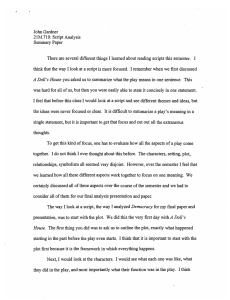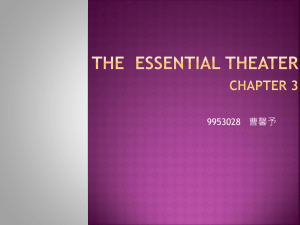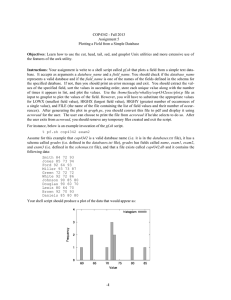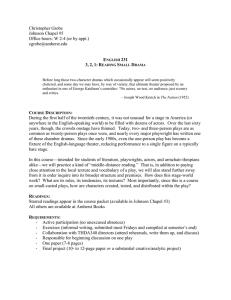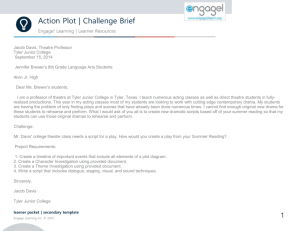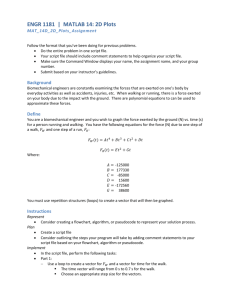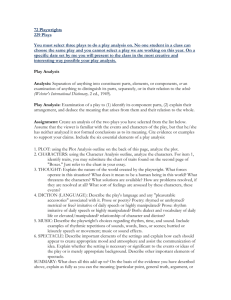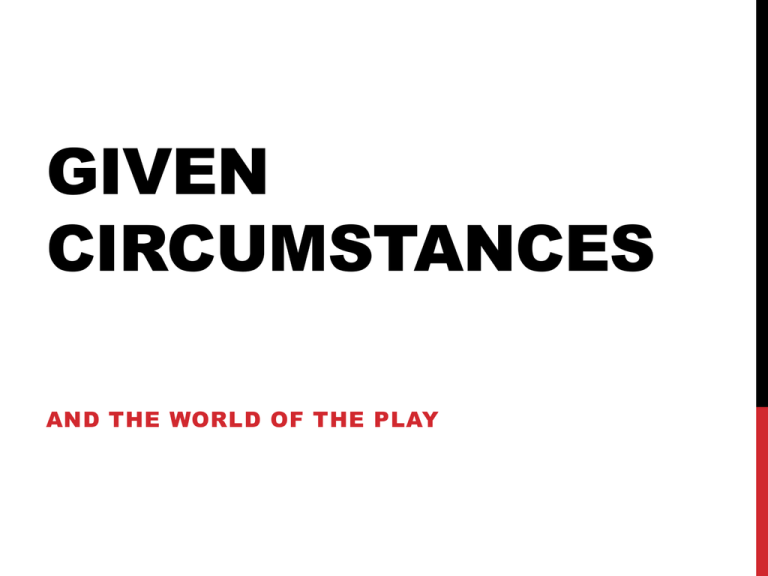
GIVEN
CIRCUMSTANCES
AND THE WORLD OF THE PLAY
PLAY-ANALYSIS
(FROM HODGE, 57-58)
GIVEN CIRCUMSTANCES
Environmental facts
1. Geographical
4. Political
2. Date
5. Social
3. Economic
6. Religious
Previous action
Polar attitudes of principal characters
Significance of the facts in the total meaning of the play
HOW DO YOU IDENTIFY
THE GIVEN
CIRCUMSTANCES?
Analyze the text - simply look at all the
information relating to the character that the
dramatist tells you (or what you can discern
from the comments). Pick out the most
significant elements. If you go around
telling everyone (whoever you are) you have
always depended on the kindness of
strangers, people can only draw their own
conclusions about what you've been up to.
READ ME
FROM A CLASS BLOG AT THE
UNIVERSITY OF IOWA
The Given Circumstances
Script Analysis is the class that scared the most out of me…
(In conversations with others, this is pretty much a universal fear.)
The fundamental principle of the professor seems to be that graduate
students in theatre nearly universally come from some sort of
theatrical background and need to be shown how to read a script.
We need to re-learn the art of reading the script, so as to better grasp
the "given circumstances" present in the text - answering the
questions "who," what," and "when" among many, many others. The
"given circumstances" chip away at the basic facts of the play in
order to better see the motivations and it is only after answering
these questions that a convincing performance of any contemporary
work can be delivered, or can the reader adequately understand what
the playwright was going for with language. It's a good idea. But it's
daunting.
We're expected to want to get this
information that is in the text. And for
the most part, I really do.
I want to write plays. I want to have
them read, and performed and
understood. This is what I (thought) my
life should be about. It's at least what I
want to (eventually) get paid for.
The problem is it's hard. Reading the
plays for this stuff is tough. I just want
the plot. Second, I want the images -what can I put on the damn stage to
make an audience like the words? By
that point, I had always thought I'd
exhausted the text.
Apparently not.
What do you discuss with the director? What sort
of conversation would you have? I listen to the
director's ideas or try to visualize what the director has
in mind. In terms of process we discuss what is in the
heart of the piece and how to communicate that to the
audience visually in design process. When scenes are
in multiple locations it is important to ask how we
transition from one location to the other. It is a way of
thinking together and hearing each other's ideas.”
--Designer Myung Hee Cho
Well-written plays have a
BEGINNING-MIDDLE-END.
An inciting incident kicks off the ACTION of the play. A sequence of actions
is defined as plot.
PLOT is the imitation of the action...the arrangement of the incidences
CHARACTER, the agents of the plot
THOUGHT (THEME) is a general truth enunciated
DICTION is the expression of the meaning in words
SONG is an embellishment whose sense everyone understands
SPECTACLE is the least artistic, connected least with the art of poetry
A plays BEGINNING lays out its GIVEN CIRCUMSTANCES.
Time and place
Social circumstances, age, sex, etc. of characters
Prevailing mood/atmosphere
In short, details provided by playwright to create the world of the play
GIVEN CIRCUMSTANCES are uncovered
by careful reading of what characters say
and the stage directions
WHO
The people of the play (Characters)
PROTAGONIST is who the play is about and the
ANTAGONIST prevents the protagonist achieving their goals
WHEN
The specific time of the action and its elapsed time.
WHERE
The environment of the script. Geographical and exact
WHAT
The major conflict as expressed in previous actions
GOAL OF ANALYSIS FOR
GIVEN CIRCUMSTANCES
UNLOCK a script’s structure to clarify the ACTION
Understanding a play’s structure is like having a blueprint.
Most longer plays will require additional RESEARCH.




